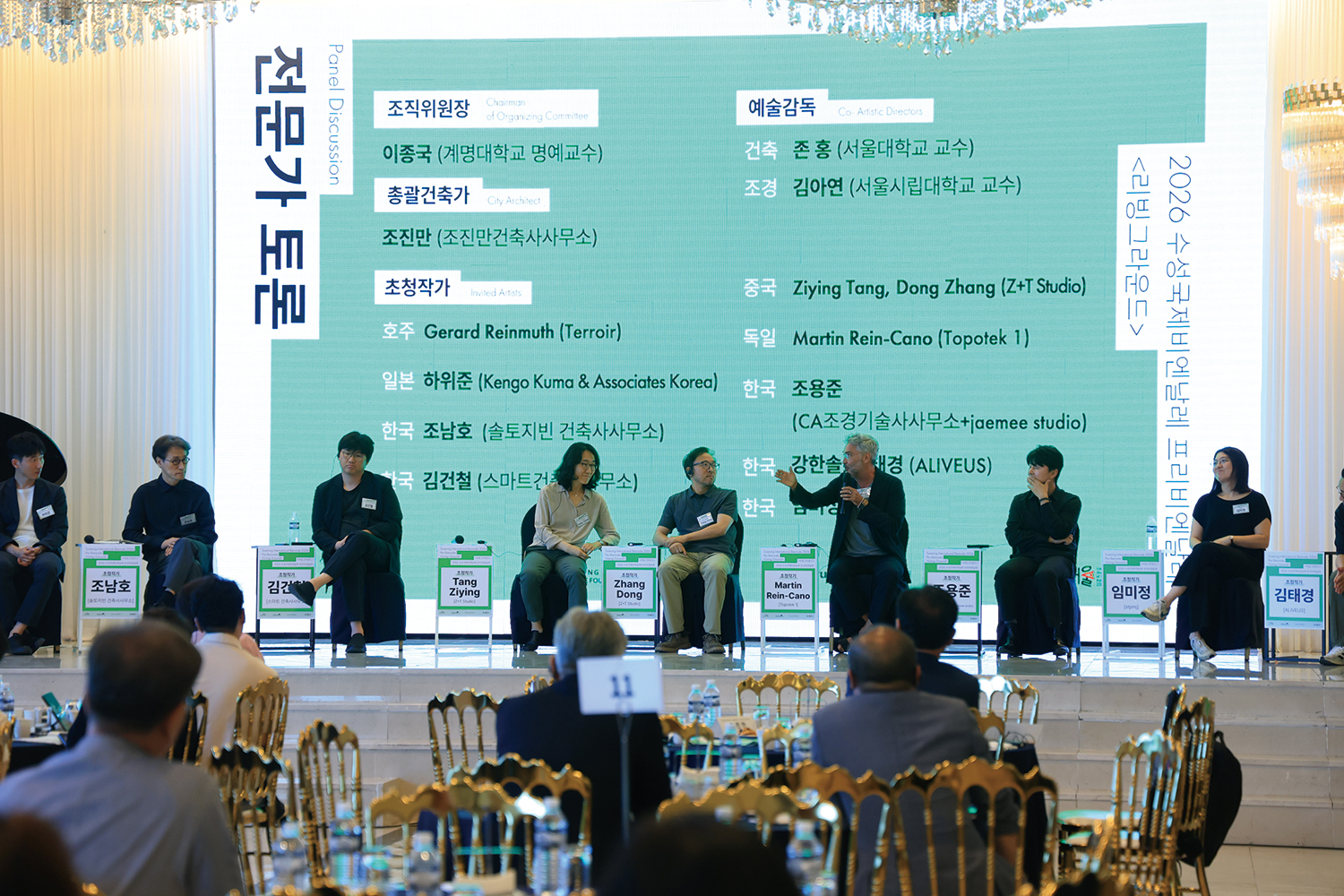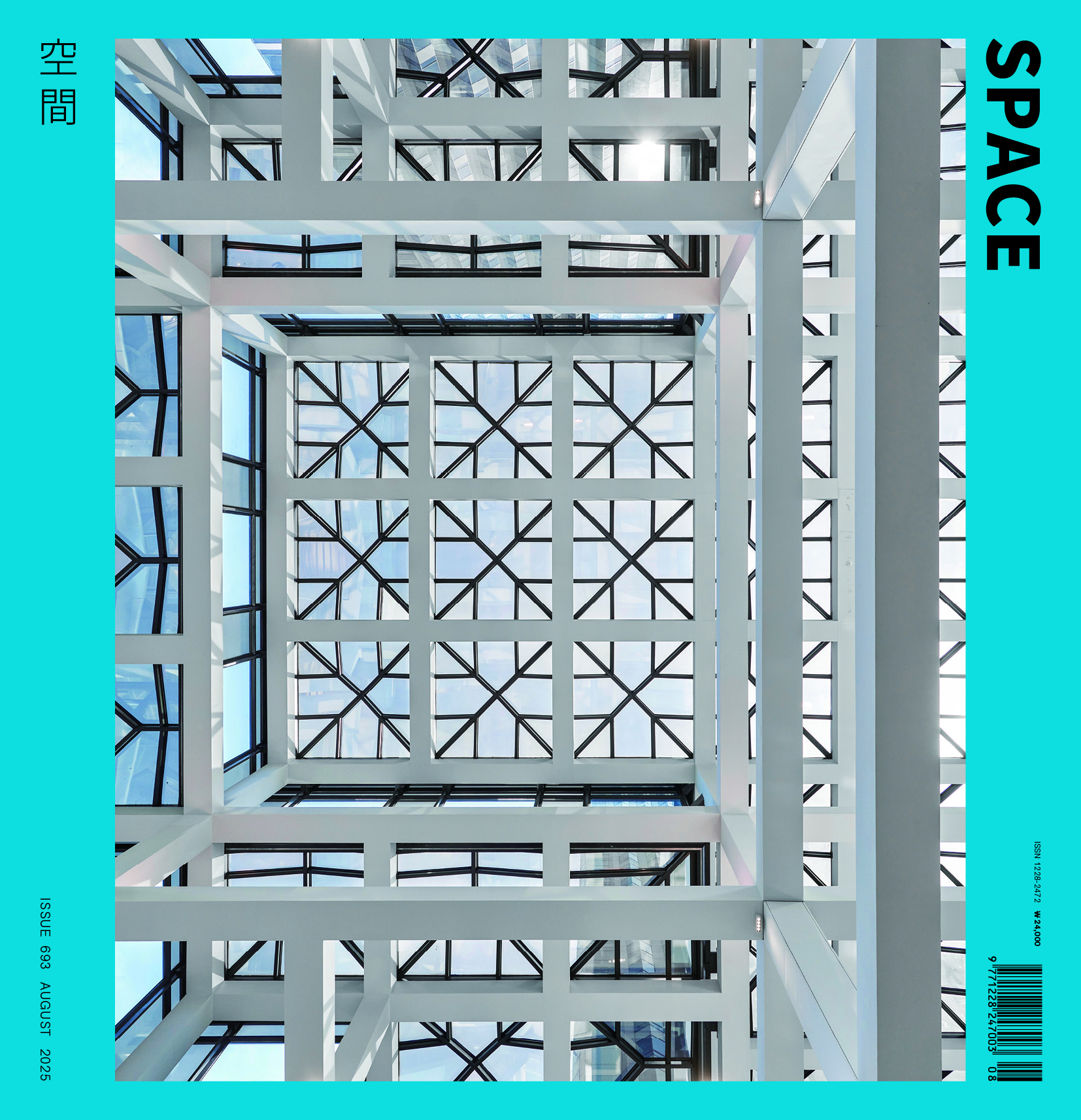SPACE August 2025 (No. 693)

The co-artistic directors; Kim Ahyeon (left) and John Hong (right). Image courtesy of Suseong-gu Office

A roundtable discussion with eleven participating artists, co-artistic directors and the chairman of the organising committee. Image courtesy of Suseong-gu Office
On July 9, the Pre‑Biennale for the 2026 Suseong International Biennale was held at the Hotel Susung, Peony Hall. From its first edition, the Suseong International Biennale – which bonds both architecture and landscape design – appointed co-artistic directors from each discipline. On this occasion, Kim Ahyeon (professor, University of Seoul) and John Hong (professor, Seoul National University) were designated co-artistic directors and they introduced their elected theme ‘Living Ground’.
‘Living ground’ is not an independent theme, and should instead be understood as an extension of the first Biennale’s theme, ‘Relational Field’, which emphasised land as a stage on which relationships are formed and a site of tangible creative practice. The second edition continues this legacy by again foregrounding the shared concept of land. Instead of viewing the ground as a passive resource, this time it is conceived as a living, active subject that shapes ecosystems.
One notable aspect of the Suseong International Biennale is its focus on implementation, aiming to bring palpable change to urban space. As part of the upcoming biennale, a series of invited design competitions is currently underway for several architectural and landscape projects: Jinbat-gol Wood-Friendly City, Yeonho District Small-Scale Galleries, Deuran Art Village Children’s Art Parks, Naegwan-ji Forest Plaza Restroom and Suseong Pavilion (The Pavilion of Uksuji). Given that this is an ‘implementation-oriented’ biennale, the realisation of the theme is ultimately in the hands of the architects and landscape architects. To that end, the Pre-Biennale included a discussion session where designer participants in the competition shared their perspectives on the theme and engaged each other in dialogue.
Cho Namho (principal, Soltozibin Architects) introduced a Korean term, sallimsari, which refers not only to sustaining one’s own life and enabling other beings to flourish on this land, but also to the full range of economic activities that support life. Furthermore, he believed that ‘living ground’ which speaks to the philosophy of sallimsari could be a way of living that heals and transcends the instrumentalisation, degradation, and exploitation of the earth.
Tang Ziying (co-principal, Z+T Studio) gave a presentation entitled, ‘Living Ground: Beyond the Green’. In this lecture, her main argument was that though people in contemporary society tend to spend more time in virtual spaces, they still have a deep-rooted desire to connect with other living organisms. True happiness, she argued, can be achieved only when humans live alongside other diverse life forms. As a landscape architect, she expressed her interest in leading people out of their comfort zones, from indoor spaces into messy outdoor spaces filled with mud and mosquitoes.
On behalf of Kuma Kengo, Ha Wuijoon (director, Kengo Kuma & Associates Korea) shared the interpretation of ‘living ground’ as the everyday spaces in which diverse individuals can gather, spend time, and engage in various activities. His presentation featured images of ordinary people enjoying ordinary moments: spending time along Cheonggyecheon Stream, watching street buskers in Sinchon, or playing chess in the park. These images suggest that ‘living ground’ is not limited to greenery and nature, but draws upon all places in which people live and interact.
Eleven participating artists, two artistic directors, and the chairman of the organising committee held a roundtable discussion after the presentations. During the discussion, Martin Rein-Cano (principal, Topotek 1) argued that the dichotomy of human versus nature must be eradicated, adding that it is important to reject both the romanticisation and objectification of nature. He further argued that either abusing nature or protecting victims of exploitation with a patronising attitude are outcomes of treating nature as an object and we must learn to recognise and accept nature as it is.
It is somewhat disappointing that the ongoing project related to this Biennale shares similar limitations, that is a tendency to prioritise new construction as with other conventional international design competitions. However, could this biennale’s structure – run directly by Suseong-gu Office and the Suseong Cultural Foundation, rather than a separate biennale foundation – offer a stronger basis for more experimental approaches in public architecture? The Suseong International Biennale is expected to continue in the future, with new projects in development—this is something to look forward to. The main biennale is scheduled to open in Oct. 2026.





